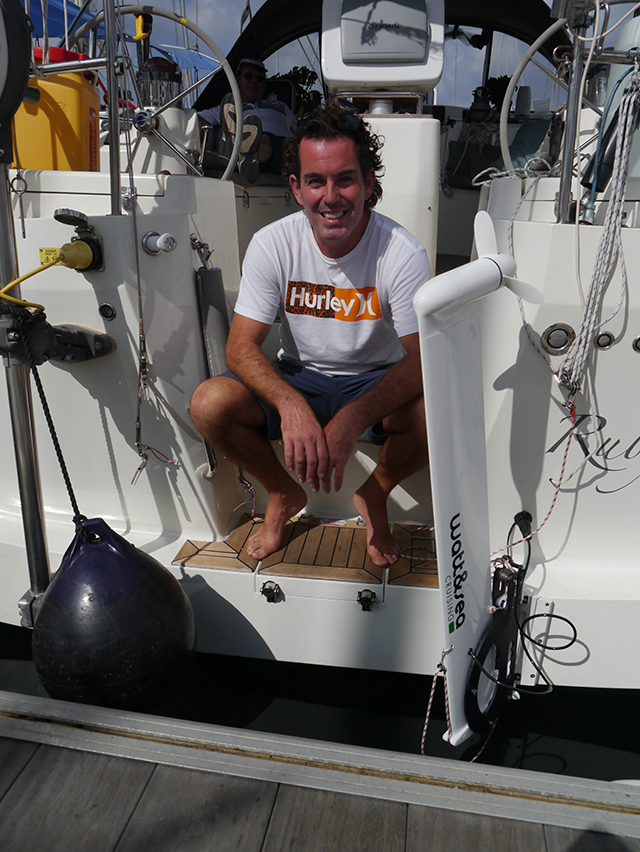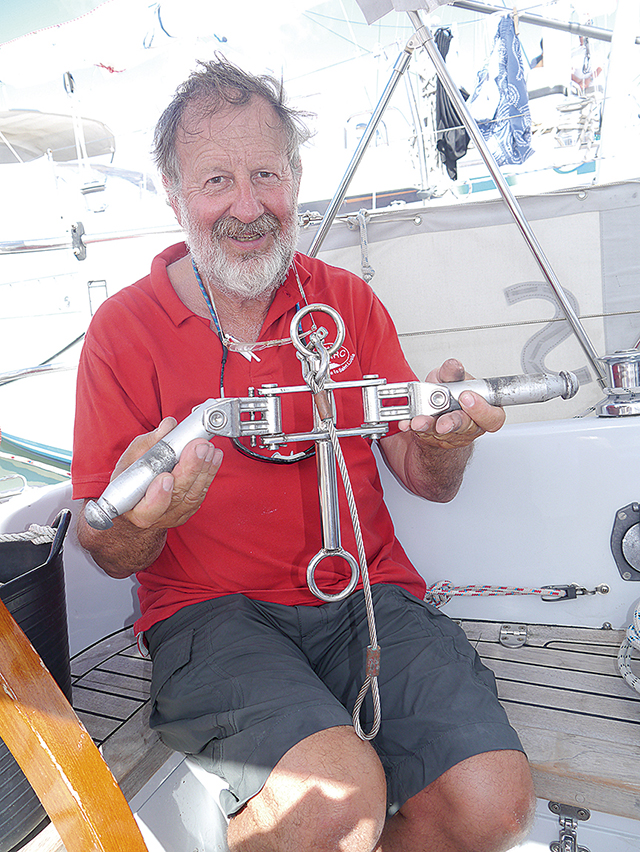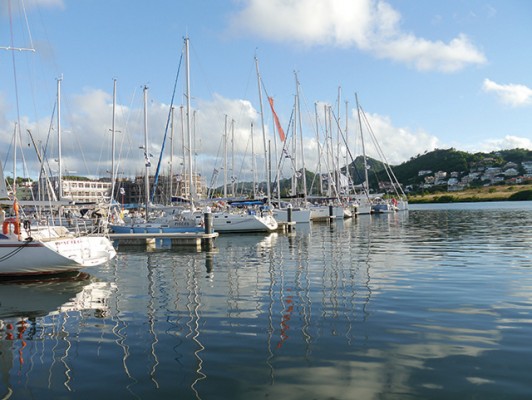Laura Hodgetts talks to the skippers of 20 boats on the Atlantic Rally for Cruisers (ARC), ‘the biggest downwind gear test of the year’, about the pros and cons of the equipment they used and the sailing techniques they deployed
However, this reassurance cannot apply to equipment on board. For sailing cross-Channel, or just for a few days offshore around the UK, most power sources and gadgets on board will only be tested for a few hours.
During the Atlantic Rally for Cruisers (ARC), the passage will take around three weeks for small boats, and with 256 boats all making the 2,700NM passage simultaneously, downwind with the trades, it’s the ultimate gear test.
During last year’s 30th anniversary rally, strong winds from day one made for an ‘exceptionally fast crossing’, with a larger than usual number of breakages of gear and sails.
PBO spoke to the skippers of 20 ARC cruisers about equipment highs and lows and sailing techniques to see what lessons were learned across the boats.
Power generation

Nick Fabbri and the Watt&Sea hinge-down towed generator on his Southerly 38 Ruby Rose
Keeping boat batteries topped up and supplying electricity to an increasing number of gadgets is a major issue, from mod cons like fridges, freezers and watermakers to autopilots. Running diesel engines to generate power can be hot and noisy, so it’s not surprising that green products are popular choices.
Watt & Sea hydrogenerators, retailing from £2,878, dominated at the 2015 ARC. Dozens of yachts sported the unit, which hinges down from the transom. Available in two lengths and with three propeller options, the larger prop is claimed to deliver 120W at five knots on either the 300W or 600W unit – the larger model allows for higher speeds.
ARC weather forecaster Chris Tibbs, who owns the Wauquiez Centurion 40S Taistealai, said: ‘It was massively worth the money, except near the end when we hit all the Sargasso weed. We had to lift it there.’ Assisted by a solar panel and wind turbine, the hydrogenerator ran Taistealai’s
fridge, freezer, Raymarine instruments and watermaker.
World Cruising Club’s Jeremy Wyatt, who crewed for Chris, said: ‘We didn’t expect any juice from the wind turbine but it whizzed away quite happily. Solar panels don’t work at night and can get shaded by the spinnaker, so the hydrogenerator is the most efficient way to get power across an ocean.’
Jeremy said the Watt & Sea made a slight noise when dumping excess power until they fixed a loose wire in the charge box. ‘It’s a very good product, but the peripherals are not very well engineered. It produced 10A every hour, 10 hours a day.’
Skipper Anders Sundqvist of the Hallberg-Rassy 42F yacht Cavatina was ‘very happy’ with his Watt & Sea’s performance. He also found Sunbeam System’s removable solar panels ‘better than the fixed ones’ and ‘particulary efficient’ when sited on top of the bimini.
Both Southerly 38 Ruby Rose skipper Nick Fabbri and the Hallberg-Rassy 310 Inua’s skipper Enno Rodegerdts noted ‘a flaw’ with the Watt & Sea lifting bracket design, which is supposed to lock into place but lifted up when the waves moved it to the far right. Nick had to reinstall his hydrogenerator’s charge controller at sea.
He added: ‘It’s a genius idea, but I think the figures for energy production are under laboratory conditions. Also, the plug socket it comes with is not fit for purpose. The thread’s gone already.’
A custom-made Watt & Sea fitting on the 100% electricpowered Maestro 40 Limone broke on the first night. A 5mm metal bar had been used to make the hydrogenerator fit the cruiser, which does not have a straight stern.

Limone’s DIY repair to the Watt&Sea hydrogenerator fitting using small aluminium pieces, rope and a washing up brush
Skipper Janne Kjellman said once repaired, using aluminium pieces, a rope and a washing-up brush, the hydrogenerator ‘worked really well’ along with solar panels and Limone’s Oceanvolt SD15 saildrive electric motor system, which operates as a generator at six knots or more.
AWOL owner Cliff Crummey found his DuoGen combined wind and water battery charger ‘more efficient in water mode than wind’ aboard his Elan Impression 444.
He said: ‘It provided an amp a knot, supplying me with absolutely everything, until the weed turned up 1,000 miles from St Lucia. We left it out and ran the main motor. Now, knowing about the seaweed, I would’ve just fitted a little diesel generator instead.’

AWOL’s Cliff Crummey found his DuoGen ‘more efficient in water mode’
Contessa 32 Pisces’s owner Paul Thompson found their petrol four-stroke generator ‘a bit too small: we had to run it six hours a day to keep the batteries up.’
Island Packet 440 Seraphina of Chichester skipper Jonathan Paull was pleased with his ‘un-green’ Paguro diesel generator. ‘We’d planned to run it four hours a day, but had to run it around six hours.’
Both Starlight 39 Rhumb’s new diesel generator and watermaker ‘just stopped working’. Skipper Brian Alderson said each had cost around £500, and added: ‘It was so disappointing. We had about 200lt of bottled water, enough for cooking and drinking and the occasional splash. We had to run the engine for power, which used more fuel, was noisy and made the cabins hot.’
Essential items

The crew of Chanto with the Hydrovane Self Steering system (left)
The crew of the Bowman 48 Chanto initially used an autopilot, but when this ‘packed in’ their Hydrovane wind self-steering systems came up trumps. ‘Brilliant’ was the word used by Chanto’s
Nicky Harvey.
Ruby Rose’s Nick Fabbri said: ‘That Hydrovane, I’d marry it if I could.’
Duco Pulle, skipper of the Najad 34 yacht Briet, said: ‘My Hydrovane was in use 90 per cent of the time. It really reduced the workload: no energy use and very quiet.’ Duco also recommended the Nasa AIS receiver and a PUR watermaker that made 5lt an hour and ran into a separate tank.
He said: ‘I ran that two hours a day, which is also the time I used to charge the batteries.’
Anna Mayor, who sailed double-handed aboard the Rustler 42 Pantalaimon II, also praised the Hydrovane: ‘We had it on from day two until we arrived in St Lucia’.
Another top item was a Walder boom brake, recommended by Tim Sweet from Toronto, Canada, who was sailing double-handed aboard his Malö 42 Belafonte. ‘It gave us a lot of confidence when short-handed.’ Tim’s other essential item was ‘an eBook.’
Anders Sundqvist also recommended an Echotec mechanical watermaker and cushion seats with back support.
According to Nick Fabbri, ‘the breadmaker was a morale booster.’ Nick, his partner Terysa and two crew took ‘980 euros of food with us, and we weren’t living on quail eggs and stuffed partridges.’
Best buys included M&S chunky chicken in a tin, earplugs for sleeping and little cabin fans which also drowned out noise. Mittens on the spreaders with ‘industrial Velcro and bits of old bath towel’ prevented chafe.
Limone’s skipper Janne said their watermaker failed, so his crew used ‘tanks and bottled water for drinking.’ A fish smoker fuelled by wood chips was used to cook the nine ‘mahi-mahi’ they caught.
Jeremy Wyatt recommended radar as ‘great for showing up squalls’, and insulated, no-spill drinking flasks for the night watch, plus home-made beanbag pillows that squashed to fit the shape of the bunk.
He added: ‘We also had individual flasks for cold drinks. It was good to see how much you were drinking as it’s easy to get dehydrated.’ Dioralyte rehydration mix proved to be an immediate ‘pick-me-up’ when required.

‘No boat is so small it can’t have a teapot with cosy’ says Pisces’ Paul Thompson
Aside from tea and sugar, the Contessa 32 Pisces duo Paul Thompson and David Everett couldn’t have done without their Iridium Go Wi-Fi hotspot, which connected to their iPhone and iPads.
David said: ‘It worked perfectly every single time. It was well worth the £15 a day.’
Seraphina of Chichester skipper Jonathan said: ‘The most useful utensil was our Prestige electric cooking pan from Tesco: you just throw everything in and it makes really good, quick meals.’
Rhumb’s crew were impressed with their Iridium Satellite phone from MailASail, but not the charges. Brian said: ‘I received a bill for £150 halfway through the journey.’
New aft quarter corner seats were ‘fantastic for the watches.’ Brian advised future ARC sailors: ‘Preparation is everything. Insurance is very important, getting EPIRBs and phones registered. We’ve got a DSC handheld VHF, and had to register that separately.’
Emily Morgan co-owner ‘Bones’ Black recommended the Harken chair for going aloft. ‘Before we left Plymouth I spent two days up and down the mast, redoing sheaths, refurbishing furlers. It’s twice as difficult to do work like that at sea.’
Sailing techniques
Taistealai was among the 37 boats that used a Parasailor – a spinnaker with a wing designed for safe and easy downwind sailing.
Chris Tibbs, who skippered in the first ARC, said: ‘We were probably 65% poled out with the headsail, spinnaker or Parasailor.’ Chris, Helen and their two crew hand-steered the 40ft Taistealai all the way, ‘just because you go faster’. ‘It took us 16 days: we were pleased to be coming in with the 50/60-footers.’
Parasailor’s Thomas Wibberenz said: ‘Many halyards and Parasailors chafed through. People had not really tried them out on the way down to Gran Canaria.’ He said a leading block to enable the spinnaker to articulate freely 180° would ‘solve most of the problems’.
Dawn Kelly of Dawn Chorus found her Southerly 42RST yacht went better upwind than down.
She said: ‘The Southerly’s spreaders are quite narrow so we couldn’t get a great angle on the main.’ She added: ‘There were times when the sea state was so bad, using a windvane for steering made it impossible to go where you wanted. We used our autopilot, which drained the batteries.
‘We had to come up with a fuel budget for the batteries from about halfway through the trip, running the engine in neutral to charge the batteries for an hour in the morning and afternoon.’
Their sailing technique was: ‘Learn on the hoof and complain about how hard it is. We discovered, after many repairs and a becalming, that if we set the Code Zero on a pole raked high upwards and forwards there was no more banging and slapping, then we didn’t change it for days.’
Rhumb’s sailing method was: ‘gull-winged with a poled-out genoa and a preventer on the main.’ Skipper Brian said: ‘We got stuck in the doldrums for three days, which ruined our chances of a quick crossing. We’ve spoken to many people who hand-steered, but we found the autohelm to be a comfortable system. Full marks to Raymarine on that.’
Seraphina of Chichester used a whisker pole for the genoa until a sudden swell and accidental gybe left the pole separated from the track, which became twisted.
Skipper Jonathan said: ‘Having the cruising chute on one side and the genoa out on the other was successful for us up to about 9-9.5 knots.’
In light winds Pantalaimon II sailed with twin headsails, a Code Zero and a downwind yankee, both poled out. In stronger winds, a reefed main on a preventer and goosewinged, poled-out, downwind yankee ‘sailed really nicely.’
Twistle rig

Pisces’ David Everett and the twistle rig
The double-handed Pisces had a twistle rig with twin headsails poled out, with a double hinge in the middle with a downhaul and the spinnaker pole uphaul holding the hinge fitting.
This set-up allows the sails to swing around the deck so the rig can roll and the boat doesn’t have to go with it.
Skipper Paul said: ‘It was completely brilliant.’
David agreed: ‘It’s at its best dead downwind. The lines are completely free of everything else, so no chafe.’He added: ‘The twistle can comfortably go 30° either side of downwind. We were going straight downwind where other boats were gybing.’
-
- ARC 2016 will depart Las Palmas, Gran Canaria on 20 November.
All the skippers agreed that the best part of the ARC was the amazing welcome in St Lucia, the pontoons were awash with people cheering and leaping around.
Nick Fabbri said: ‘When I’m 110 I’ll look back, and that will be a highlight of my life.’
Find out more at www.worldcruising.com/arc




